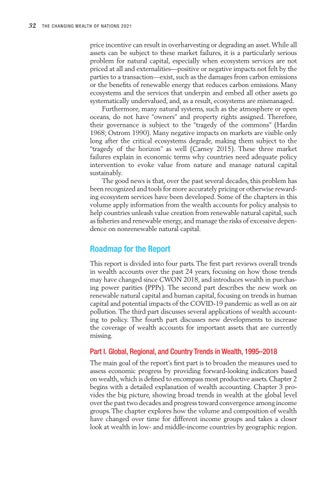32
T H E C H A N G I N G W E A LTH O F N ATIO N S 2021
price incentive can result in overharvesting or degrading an asset. While all assets can be subject to these market failures, it is a particularly serious problem for natural capital, especially when ecosystem services are not priced at all and externalities—positive or negative impacts not felt by the parties to a transaction—exist, such as the damages from carbon emissions or the benefits of renewable energy that reduces carbon emissions. Many ecosystems and the services that underpin and embed all other assets go systematically undervalued, and, as a result, ecosystems are mismanaged. Furthermore, many natural systems, such as the atmosphere or open oceans, do not have “owners” and property rights assigned. Therefore, their governance is subject to the “tragedy of the commons” (Hardin 1968; Ostrom 1990). Many negative impacts on markets are visible only long after the critical ecosystems degrade, making them subject to the “tragedy of the horizon” as well (Carney 2015). These three market failures explain in economic terms why countries need adequate policy intervention to evoke value from nature and manage natural capital sustainably. The good news is that, over the past several decades, this problem has been recognized and tools for more accurately pricing or otherwise rewarding ecosystem services have been developed. Some of the chapters in this volume apply information from the wealth accounts for policy analysis to help countries unleash value creation from renewable natural capital, such as fisheries and renewable energy, and manage the risks of excessive dependence on nonrenewable natural capital.
Roadmap for the Report This report is divided into four parts. The first part reviews overall trends in wealth accounts over the past 24 years, focusing on how those trends may have changed since CWON 2018, and introduces wealth in purchasing power parities (PPPs). The second part describes the new work on renewable natural capital and human capital, focusing on trends in human capital and potential impacts of the COVID-19 pandemic as well as on air pollution. The third part discusses several applications of wealth accounting to policy. The fourth part discusses new developments to increase the coverage of wealth accounts for important assets that are currently missing.
Part I. Global, Regional, and Country Trends in Wealth, 1995–2018 The main goal of the report’s first part is to broaden the measures used to assess economic progress by providing forward-looking indicators based on wealth, which is defined to encompass most productive assets. Chapter 2 begins with a detailed explanation of wealth accounting. Chapter 3 provides the big picture, showing broad trends in wealth at the global level over the past two decades and progress toward convergence among income groups. The chapter explores how the volume and composition of wealth have changed over time for different income groups and takes a closer look at wealth in low- and middle-income countries by geographic region.


